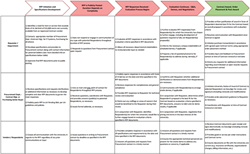The intent of this page is to provide information regarding the purpose of and differences between the Invitation for Bid (IFB) and Request for Proposals (RFP) processes used to comply with the State of Alabama Bid Law. The role of the Purchasing Department is to lead campus partners through all bid processes. Please contact the appropriate Buyer for guidance if you feel your acquisition will require a competitive bid.
State of Alabama Bid Law
Per Article 5 of Section 41-4 of the Code of Alabama, any purchase request or contract for like or similar products and/or services that exceeds the University’s small dollar purchase threshold of $75,000 must be competitively bid (with limited exceptions). A purchase request or contract cannot be split up to avoid the $75,000 bid threshold. Review Alabama’s Competitive Bid Law.
Competitive Bid is Required If:
- Purchase value is $75,000 or more
- No Approved Contract is available through UA, UA System affiliate, State of Alabama, or Cooperative
- Goods or Services can be acquired from more than one source
See Sole Source requirements if only one source is available for your acquisition
Request for Proposal vs. Invitation for Bid – THE DIFFERENCE
An Invitation for Bid (IFB) or request for a price quotation is used when the specifications of a product, service, or software are already known and when the price is the main or only factor in selecting the successful bidder. A contract is awarded on the basis of price to the lowest responsive and responsible bidder
In contrast, a Request for Proposal (RFP) involves more than a request for price. An RFP is a solicitation in which the University requests proposals for a particular project or program and typically anticipates a long-term relationship between the University and the awarded Respondent.
An RFP should reflect the Requester’s strategy and short/long-term business objectives to enable Respondents to provide detailed solutions. The more detailed the RFP specifications, the more likely proposals will be detailed and accurate.
Other factors to consider when comparing IFB to RFP:
| IFB | RFP | |
|---|---|---|
| Value | Lowest Cost; Good Value | Not always the lowest cost; Best Value |
| Terms & Conditions | Minimum requirements – no exceptions | Compliance exceptions may be allowed; questions may be submitted for clarification of exceptions |
| Specifications | Specific minimum requirements for performance or design. Indicating exactly what you want | The results are determined by the Scope of Work. Asking for respondent to develop and provide a solution. |
| Evaluation Process | Compare costs; compare specs to bid; evaluate bidder | Evaluation team; Evaluation criteria set forth in RFP; Respondent demonstrations |
| Evaluation Criteria | Low bid; must meet specs; lowest responsive and responsible bidder; no changes allowed | Understanding of requirements; meets minimum requirements; approach and work plan; qualifications and experience; identification of risk; resources; forward-thinking ability, etc. |
The charts below outline the responsibilities of the following stakeholders through the entire bid process: the requesting department, Purchasing department, and vendors.
Invitation for Bid (IFB) Specification Writing Guidelines and Tips:
Competitive bid specifications should clearly state the minimum requirements necessary to achieve the overall goal of the procurement. Specifications should not be so specific that they limit competition by the inclusion of unnecessary unique requirements.
There are multiple types of specifications depending on the type of good or service needed, including, but not limited to:
| Type | Description | Measurable Examples |
|---|---|---|
| Performance Specifications | Describe what a good or service is expected to do by defining desired result using performance indicators | Examples: power, strength, test methods, standards of acceptability, response time |
| Design Specifications | Establish material and operating requirements of goods needed to meet minimum acceptability | Dimensions, chemical composition, physical properties, materials, ingredients |
| Combination Specifications | Combination of performance and design specifications as described above | See above |
| Brand Name or Equal | Specific description including manufacturer, and /or catalog number, and / or model number. | Must include “or equal” in order to allow competition |
Good quality specifications streamline the procurement process, whereas poor specifications cause unnecessary delays and award complications. The following provides additional guidance in developing quality specifications.
Specification Writing Checklist:
- Determine the appropriate type of specification
- Include only essential information in the specifications required for the function of purchase
- Exclude non-essential information not necessary for the function of purchase
- Do not be too restrictive – Specifications should be capable of being met by more than one bidder
- Write in a simple, clear, and concise method
- Clearly identify goods and /or services sought
- It should be organized and categorized
- Clearly, state intended use
- Clearly state required lead time, when applicable
- Clearly define any compatibility requirements (e.g., brand/model, connectors, interfaces, etc.)
- Identifiable with some brand or specification currently on the market and available when possible.
- Must include “or equal” when a specific product is specified
- Clearly define any special terms, conditions, reports, testing, warranty, maintenance, etc.
- Clearly define bidder qualification and reference requirements when necessary
- Have a clear method for determining if requirements have been met
- Be mindful of terminology – Understanding the proper connotation for terms such as “shall,” “may,” “and” “or” “must,” etc.
- Use accurate technical and trade terminology
- When samples are required, all requirements of samples, including how they will be used in evaluation for an award, should be included
